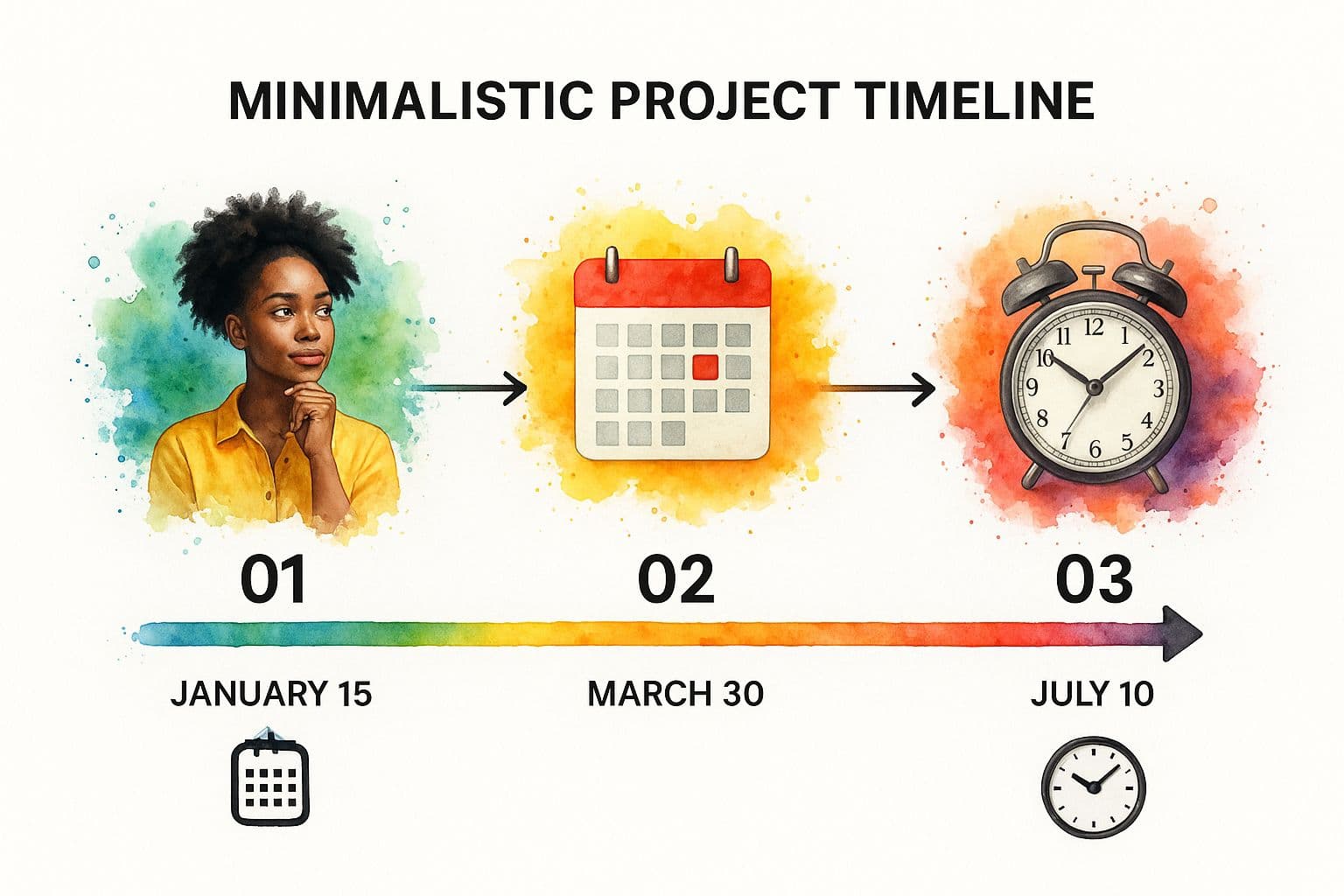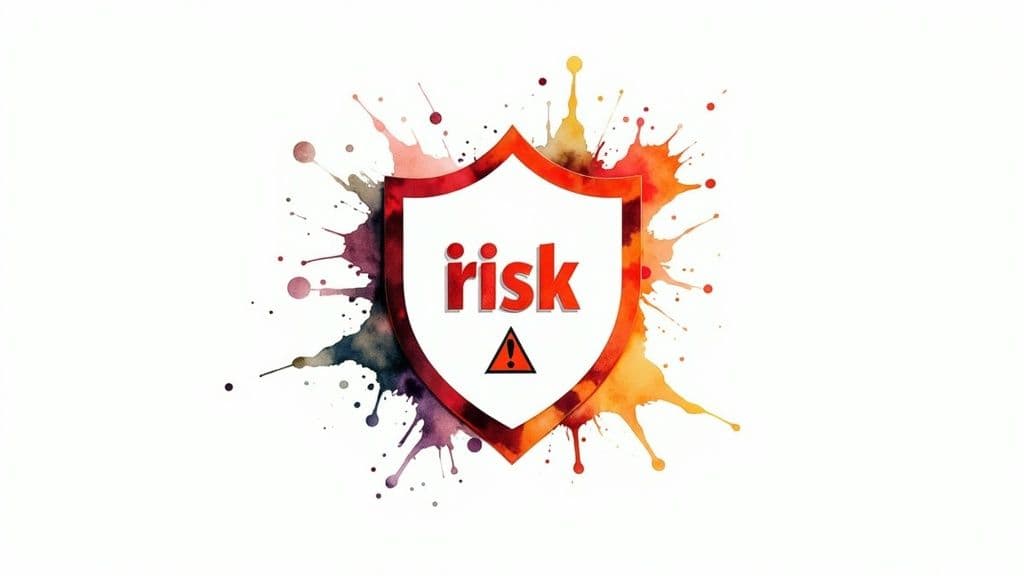Learn how to create a project plan that keeps your team on track. Discover easy tips to develop an effective project plan today!
October 8, 2025 (1mo ago)
How to Create a Project Plan: Step-by-Step Guide
Learn how to create a project plan that keeps your team on track. Discover easy tips to develop an effective project plan today!
← Back to blog
A solid project plan is your blueprint for success. It’s more than just a to-do list; it’s the roadmap that guides your team from start to finish, making sure everyone's aligned, resources are used wisely, and potential roadblocks are handled before they become full-blown crises.
Think of it as the difference between having a GPS with real-time traffic updates and a hastily scrawled list of directions. One gets you where you're going efficiently; the other usually leads to a lot of wrong turns and frustration.
Why Most Project Plans Fail

Let's be real for a minute. Most project plans I've seen over the years were pretty much doomed from the start. They were just glorified to-do lists—nice-looking documents that seemed impressive in a meeting but fell apart the second reality hit. They were reactive, not proactive.
This usually happens because the plan is treated like a static document, a box to check off at the beginning of a project. But a truly effective plan is a living, breathing guide. It evolves and adapts. It should be the central nervous system of your project, not some dusty artifact.
From Task List to Strategic Roadmap
The big mistake with a simple task list is that it completely ignores the messy, interconnected nature of how things actually get done. It tells you what to do, but it doesn't say a thing about dependencies, resource limits, or the inevitable risks lurking just around the corner. A strategic project plan, on the other hand, ties every single action back to the overall business goals.
A well-structured project plan brings clarity and control to what can easily feel like a chaotic process. It’s your single source of truth that helps you stop budget overruns and missed deadlines before they even happen.
To help you build a plan that has some real strategic depth, let’s look at the core parts that separate a true roadmap from a simple checklist.
Here’s a quick overview of what a strategic plan includes, which we'll dive into throughout this guide.
Key Components of an Effective Project Plan
| Component | What It Is | Why It Matters |
|---|---|---|
| Clearly Defined Scope** | A precise outline of project deliverables, boundaries, and what's not included. | Stops "scope creep" and makes sure everyone agrees on what "done" actually means. |
| Milestones & Timeline | Key checkpoints and a realistic schedule with all the dependencies mapped out. | Gives you a clear path forward and helps you track progress against major goals. |
| Resource Allocation | A detailed plan for assigning team members, the budget, and any needed tools. | Makes sure you have the right people and resources at the right time, avoiding burnout. |
| Risk Management Plan | Spotting potential threats and having proactive strategies ready to deal with them. | Turns potential disasters into manageable problems, keeping the project on track. |
By building these elements into your process, you're not just planning—you're strategizing. You're creating a resilient framework that can actually handle the unexpected curveballs every project faces.
Defining Your Project Scope and Objectives
Before you can build anything—a house, a product, or a marketing campaign—you need a blueprint. For any project, that blueprint starts with defining your scope and objectives. This is honestly the most critical phase; it's where you nail down the ‘what’ and the ‘why’ with total clarity, creating a solid foundation that keeps your project from spiraling out of control later.
So many teams I’ve seen rush this step, only to pay for it with endless revisions, blown budgets, and missed deadlines. There’s a good reason for that. The Project Management Institute found that a staggering 52% of projects suffer from scope creep—that slow, uncontrolled expansion of what you're supposed to deliver. This almost always happens when the initial boundaries weren't drawn firmly enough.
Crafting Crystal-Clear Objectives
Let’s be honest: vague goals like "improve customer engagement" are useless for actual planning. Your objectives need to be specific, measurable, and tangible. The best framework I’ve found for this is still the classic SMART system.
- Specific: Say exactly what you want to accomplish. Instead of "improve engagement," try "Increase organic social media engagement on Instagram."
- Measurable: Define how you'll track success. For instance, "Increase comments and shares by 15%."
- Achievable: Make sure the goal is realistic with your team's resources and timeline. Don't set them up to fail.
- Relevant: The objective has to line up with bigger business goals, like boosting brand awareness or driving sales.
- Time-bound: Set a clear deadline. "Increase comments and shares by 15% over the next quarter."
This simple exercise gets rid of any ambiguity and gives your team a clear target. Everybody knows exactly what success looks like.
Building a Bulletproof Scope Statement
With your objectives set, you can now define the project's boundaries with a scope statement. This document lays out what is—and just as importantly, what is not—included in the project. Think of it as your main defense against scope creep.
A well-defined scope statement is the official agreement between your team and stakeholders on exactly what will be delivered. It’s the single source of truth you can always point back to when new requests inevitably pop up.
Your scope statement should clearly outline the project's key deliverables, features, and functions. For a deeper look at how to put one together, this detailed example of a project scope statement really breaks down the process well.
For instance, if you're building a new website, your scope might include a homepage, an about page, and a contact form. It should also explicitly state what's out, like "This project does not include a blog or e-commerce functionality." If you're looking for another practical walkthrough, this guide on how to write a website scope document is a great resource.
Getting this level of clarity is what gets you stakeholder buy-in from day one and prevents those costly misunderstandings down the line.
Breaking Down the Work and Mapping Milestones
Once your scope is locked down, the grand vision of your project can still feel a bit intimidating. A huge goal is often paralyzing, but the secret is to chop it up into smaller, more manageable pieces. This is where you'll create a Work Breakdown Structure (WBS), which is really just a simple way of deconstructing your main objective into actionable tasks.
Think of it like building a car. You don't just "build a car." You start with the frame, then add the engine, the wheels, and the interior. Each of those major parts is then broken down even further—the engine needs pistons, the interior needs seats, and so on.
Your project works the same way. Whether you're running a marketing campaign or launching new software, the WBS turns a huge goal into a logical hierarchy of tasks your team can actually get their hands on.
This visual shows a simple project timeline with major checkpoints, illustrating how breaking down the work makes tracking progress so much easier.

The key takeaway here is that milestones give you clear, visual markers of progress. They help everyone see how far you've come and what's just around the corner.
Identifying Your Critical Milestones
With your tasks laid out, the next step is to pinpoint your project milestones. These are the major checkpoints that show real progress and tell you a big phase of work is done. Milestones aren't the tiny, everyday tasks; they are significant achievements.
For example:
- Marketing Campaign: A milestone would be something like "Final Ad Creatives Approved," not "Draft first ad copy."
- Software Launch: Think bigger picture, like "Alpha Testing Complete," not "Fix bug #247."
Identifying these major achievements helps you track real momentum without getting bogged down in the daily to-dos. It also gives you perfect opportunities to celebrate wins with your team and keep morale high.
Sequencing Tasks and Understanding Dependencies
Now it’s time to get everything in order. You can’t install the windows before the walls are up, right? This is where you map out task dependencies—figuring out which tasks have to be finished before others can even begin.
Honestly, this is where a lot of teams drop the ball, leading to frustrating bottlenecks later on. For instance, the design team can't start creating visuals until the marketing team finalizes the campaign messaging. That's a classic dependency.
Laying this all out helps you create a logical workflow and a realistic timeline. It's no longer just a random list of things to do; it becomes a connected roadmap where each step flows naturally into the next.
A plan's true value comes out in its execution. Research shows that 77% of high-performing projects use dedicated project management software, which is essential for visualizing these dependencies and timelines. The methodology you choose matters, too; 24% of companies rely on Agile or Scrum to manage these complex workflows. You can discover more project management insights in this comprehensive 2025 report.
Assembling Your Team and Allocating Resources
Now that you've defined the project's scope and mapped out your key milestones, it's time to build the engine that will actually drive this thing forward: your team and resources. A project plan is just a document until you attach the right people and tools to it. This is the moment we shift from the abstract "what" and "when" to the very real "who" and "how."
This isn't just about plugging names into a spreadsheet. It's a strategic exercise in matching skills to the specific tasks you've already laid out. Who on your team lives and breathes creative work? Who's the data wizard with the analytical skills for the number-heavy parts? Assembling a truly balanced team means looking at both raw talent and, just as importantly, their current availability. Get this wrong, and you're setting yourself up for bottlenecks before you've even started.
Defining Roles and Fostering Ownership
To head off any confusion later, you need to be crystal clear about who is responsible for what. One of the best tools I've ever used for this is a responsibility matrix, which you might know as a RACI chart. It’s a deceptively simple grid that brings amazing clarity to team roles.
A RACI chart spells out who is:
- Responsible: The person actually doing the work.
- Accountable: The one person who ultimately owns the outcome of the task.
- Consulted: The subject-matter experts you'll need input from.
- Informed: The people who just need to be kept in the loop on progress.
Using this simple framework completely eliminates that dreaded, project-killing phrase: "I thought they were handling that." It builds a sense of ownership from day one, so everyone knows exactly how they contribute to the project's success. The result? Smoother work and a lot less chaos.
Smart Resource Allocation Beyond People
Great project planning goes beyond just your team. It also means accounting for all the non-human stuff—the budget, the software licenses, and any physical equipment needed to get the job done. I've seen more projects go off the rails due to poor resource management than almost any other reason. It leads to missed deadlines, blown budgets, and a burned-out team.
For a much deeper look at this, our guide on resource allocation in project management is a great place to start. Getting this right from the beginning sets your team up to win.
Your budget is one of the most critical resources you'll manage, and it needs a solid plan. Don't just pull numbers out of thin air. A huge part of setting realistic expectations and allocating resources effectively is mastering financial projections for your business plan.
A basic resource plan should clearly list every single thing you need, from software subscriptions to specialized hardware. Assign each resource to a specific task and pin down what it costs. This gives you a clear financial picture and makes it much easier to justify your budget requests to stakeholders. By thinking through these needs upfront, you make sure your team has everything it needs to deliver.
Anticipating Risks and Building Contingency Plans
Hope is not a strategy. I've seen too many projects go off the rails because the team only planned for the best-case scenario. A truly solid project plan doesn't just map out the sunny path to success; it also anticipates the storms and packs an umbrella.
Ignoring risk management is a classic mistake. When you look at failed projects, you can often trace the root cause back to a single, unexpected problem the team was completely unprepared for. This part of your planning is all about shifting from a reactive mindset ("Oh no, what now?") to a proactive one ("We knew this could happen, and here's what we're going to do"). You’re essentially building resilience directly into your project’s DNA.

Brainstorming What Could Go Wrong
Your first move is to get the team together for a risk brainstorming session. At first, the goal is quantity over quality—don't filter anything yet. Just get every possible "what if" scenario out on the table, whether it's on a whiteboard, sticky notes, or a shared doc.
To get the full picture, it helps to think in categories. This makes sure you cover all your bases:
- Technical Risks: What if a critical API we rely on goes down? What if we find a major bug right before launch?
- Budgetary Risks: Could a key supplier suddenly raise their prices? Is there a chance our funding could get reallocated?
- Resource Risks: What’s the plan if a key developer quits or takes an extended leave?
- External Risks: How would a new competitor launching a similar product affect us? What about changes in industry regulations?
This exercise isn't about being negative. It's about being realistic. When you identify these possibilities upfront, you rob them of their power to surprise you later.
A proactive risk management plan is your project’s insurance policy. It identifies potential threats early, enabling you to put mitigation strategies in place and avoid costly setbacks before they happen.
Assessing and Prioritizing Your Risks
Once you have a long list of potential problems, it's time to separate the minor bumps in the road from the real project-killers. You can’t create a detailed contingency for every single thing, so focus your energy where it will count the most.
For each risk you've listed, assess it on two simple scales:
- Likelihood: How likely is this to actually happen? (Low, Medium, High)
- Impact: If it does happen, how badly will it hurt the project? (Low, Medium, High)
A risk that is both high-likelihood and high-impact—like your only graphic designer leaving mid-project—demands a solid contingency plan right now. On the other hand, a low-likelihood, low-impact risk, like a minor software update causing a brief slowdown, might just need to be noted and monitored.
Using this simple matrix helps you triage your risks effectively. Tackle the high-impact, high-likelihood threats first, then work your way down. This practical approach makes sure you're prepared for the storms that could do the most damage, giving you a clear playbook when things inevitably go sideways.
Choosing Your Tools and Communication Cadence
This is where the rubber meets the road. All the careful planning in the world doesn't mean much until you put it into practice. A great strategy needs two things to work: the right tech to support your team and a solid communication rhythm to keep everyone on the same page.
Think of your tools and your communication plan as the engine of your project. Without them, even the most brilliant plan is just a document sitting on a server.
Modern project management software has become a non-negotiable for any serious team. The market for these platforms is expected to hit $7.24 billion by 2025, which tells you just how critical they are. A staggering 82% of companies already use project management software to manage their work, and for good reason. You can dive deeper into these trends with these insightful project management statistics.
Selecting the Right Project Management Software
Finding the right tool is less about a laundry list of features and more about what genuinely fits your team’s existing workflow. A platform like Fluidwave acts as a central nervous system for your project—a single place for tasks, timelines, documents, and conversations.
This kind of centralization is what eliminates the soul-crushing status update meetings and the endless, confusing email threads we all dread.
What you’re looking at here is a classic Gantt chart view. It’s a powerful way to visualize how all the pieces of your project fit together over time. More importantly, it helps you see potential trainwrecks—like a critical task dependency being missed—long before they happen. A good tool gives you a single source of truth, so there’s no more guesswork.
Establishing Your Communication Cadence
Just as important as your software is a well-defined communication plan. This isn't about scheduling more meetings; it's about making sure the right conversations happen at the right time. A consistent rhythm is your best defense against information silos and misaligned expectations.
Your communication plan should explicitly define how, when, and where updates are shared. This simple step removes ambiguity and ensures that critical information doesn't fall through the cracks.
The goal is to create a predictable flow of information. Here’s a simple but effective structure many experienced teams rely on:
- Daily Stand-ups: A quick, 15-minute sync for the core team. It's not for problem-solving; it's for sharing what you did yesterday, what you’re doing today, and what’s standing in your way.
- Weekly Progress Reports: A concise, high-level summary for stakeholders. This keeps them in the loop without dragging them into the day-to-day details.
- Instant Messaging: Perfect for those quick, informal questions that would feel too heavy for an email but need an answer now.
When you define these channels from the start, you create clarity and build a culture of transparency. If you need a more structured approach, our guide on building a project communications plan template is a great place to start.
Answering the Tough Questions: A Project Manager's Field Guide
Even the most carefully built project plan will face the real world, and that's where the hard questions start. Let's walk through a few situations that I've seen come up time and time again.
What Do We Do When the Scope Creeps?
It’s the classic situation: you're halfway through a sprint, and a key stakeholder comes in with a "small" new request. Suddenly, your perfectly planned project is at risk.
This is exactly why a well-defined scope statement is your most valuable asset. A minor tweak might be easy to absorb, but anything substantial needs to trigger your change control process. This isn't about creating red tape; it's about being professional. You need to formally assess how this new request will impact your timeline, budget, and team capacity.
Present those trade-offs to the stakeholders. The conversation shifts from a simple "yes" or "no" to a strategic decision that everyone understands and buys into.
How Do You Manage Unforeseen Delays?
Sooner or later, a delay is going to happen. A key team member gets sick, a third-party vendor misses a deadline—it's just part of the job. The first rule? Don't hide it.
In all my years of managing projects, I've learned one thing for sure: Bad news doesn't get better with time. Stakeholders will always appreciate transparency and a plan over a last-minute fire drill.
When you hit a snag, immediately shift into problem-solving mode.
- Assess the ripple effect: How does this one delay impact everything else down the line? Get a clear picture of the full consequences.
- Bring solutions, not just problems: Can you reshuffle tasks? Can you bring in extra help? Think through a few viable options before you raise the alarm.
- Communicate clearly: Go to your stakeholders with a simple breakdown: Here's what happened, here's how it affects the deadline, and here's what I recommend we do about it.
How Often Should You Really Update the Plan?
A project plan isn't a historical document you file away. It's a living, breathing roadmap that needs to reflect what's really happening. If it doesn't, it’s useless.
For most projects, I’ve found a weekly review hits the sweet spot. It's frequent enough to catch issues before they become major problems but not so often that it feels like micromanagement. In this review, you update task statuses, tweak timelines, and make sure everyone is still aligned with the big picture.
Of course, if you're running a fast-paced agile project, you might be referencing and adjusting it in your daily stand-ups. The key is that your plan must always be the single source of truth for your team.
Ready to build project plans that stand up to real-world challenges? Fluidwave gives you the structure to define scope, the visibility to track progress, and the flexibility to adapt. Get started for free and see how it works.
Focus on What Matters.
Experience lightning-fast task management with AI-powered workflows. Our automation helps busy professionals save 4+ hours weekly.